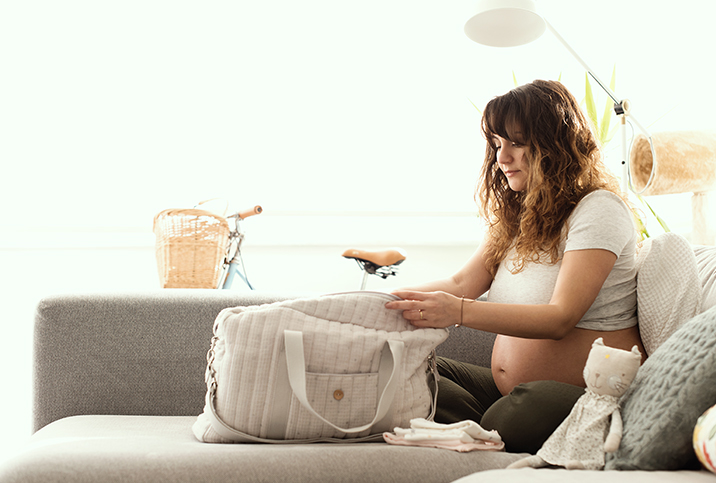What Is a Vacuum-Assisted Delivery and What Happens If You Need One?

Vacuum-assisted delivery is not something you write into your birth plan or request at the hospital, such as with an epidural. This medical intervention is not without its complications.
But it can also be unavoidable if either mother or baby is in distress. Learn about vacuum deliveries and who is at an increased risk of undergoing the procedure.
What is a vacuum-assisted delivery?
A vacuum-assisted vaginal delivery "is the vaginal birth of a baby performed with the help of a vacuum device," said Mary Jacobson, M.D., OB-GYN, and Chief Medical Officer of Hello Alpha, based in Palo Alto, California.
Sometimes it's called vacuum extraction, or ventouse. It's used in the second stage of labor (the pushing stage).
"A vacuum device is a suction cup with a handle attached," Jacobson said. "The suction cup is placed in the vagina and applied to the top of the fetus's head. Gentle, well-controlled traction is used to help guide the fetus out of the birth canal while the parent keeps pushing."
It looks more like a grabber used to pick up litter than a Hoover or Miele. While this technique is not without downsides, the vacuum can be helpful and effective in situations that meet specific criteria.
In what scenarios is a vacuum delivery used?
There are three common scenarios wherein a vacuum-assisted delivery birth may occur. These types of births are not common and represent just 2.6 percent of births in the United States, according to Cleveland Clinic.
- The second stage of labor is prolonged or stalled
- The baby's heart rate is either too high, too low or is slow to return to baseline after contractions
- The mother cannot push anymore due to physical exhaustion or a health condition
In any scenario, your baby's head must be low enough in the birth canal and in the right position to use a vacuum. Your doctor can help you weigh your options.
Sometimes, if a mother has a cardiac condition and should not push for a long time, the device will be used. Many hospitals have guidelines regarding how long a person can push before it's considered "prolonged." This time period is usually between three and four hours, depending on their pushing progress and if the baby and mother are doing fine, according to BabyCenter.
There isn't necessarily a set cut-off pushing time. The medical team will take several factors into account before talking about next steps.
A vacuum can be used when a mother is either exhausted or at the end of her pushing window and hoping to avoid a C-section.
What is the criteria for a vacuum-assisted delivery?
The rate of instrument-assisted deliveries is low: Forceps delivery accounts for roughly 1 percent of vaginal births, according to a 2022 report.
Forceps delivery rates have been falling in favor of vacuum extraction, and some practitioners no longer receive training on the use of forceps.
The following prerequisites for performing an assisted vaginal delivery (vacuum-assisted or forceps), according to the ObG Project:
- Cervix fully dilated and retracted
- Membranes ruptured
- Engagement of the fetal head
- Position of the fetal head has been determined
- Fetal weight estimation performed
- Pelvis thought to be adequate for vaginal birth
- Adequate anesthesia
- Maternal bladder has been emptied
- Patient has agreed after being informed of the risks and benefits of the procedure
- Willingness to abandon trial of operative vaginal birth and back-up plan in place in case of failure to deliver
What happens during a vacuum-assisted delivery?
This type of delivery will typically happen quickly, as its primary intent is to get the baby out fast to avoid further distress.
After consent from the parent, the suction cup is placed on the baby's head. The parent will still need to push when she has a contraction, which adds to the force. The doctor will apply force using the handle and, with their other hand, guide the baby's head out.
Once the head is out, the doctor will drop the suction and pull the body out.
What are the potential risks of a vacuum assisted delivery to mom or baby?
Vacuum-assisted delivery poses risks to both the baby and parent. You may not have time to be fully briefed on all the risks, so it can be helpful to know them ahead of time.
"A potential risk to the parent is an anal sphincter injury with possible short-term incontinence, which resolves within one year postpartum," Jacobson said.
There is also an increased risk of perineum tearing.
Risks to the baby, according to Jacobson, include the following:
- Laceration from the edges of the suction cup
- Cephalohematoma (swelling of clotted blood on the scalp) formation
- Subgaleal or intracranial hemorrhage (bleeding)
- Brachial plexus injury, or nerve injury which may affect the movement of the shoulder, arm and hand
- Fracture
Retinal hemorrhages, or bleeding of the retina and increased rates of hyperbilirubinemia have been reported.
Babies born with bruises are more likely to have jaundice, a condition caused by elevated bilirubin levels. Bilirubin is a yellow substance produced when red blood cells are broken down. Bruises are essentially made up of red blood cells.
The bottom line
While a vacuum-assisted delivery is never the go-to, there are certain situations when it becomes necessary. Fortunately, forceps and vacuum delivery are relatively uncommon. Make a birth preference, not a plan, to better help mentally roll with any changes in the birthing room.


















